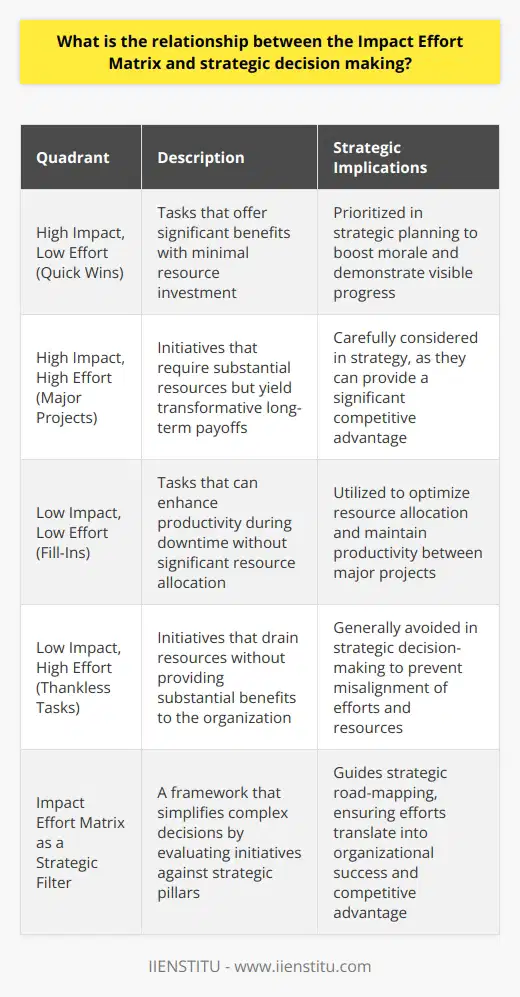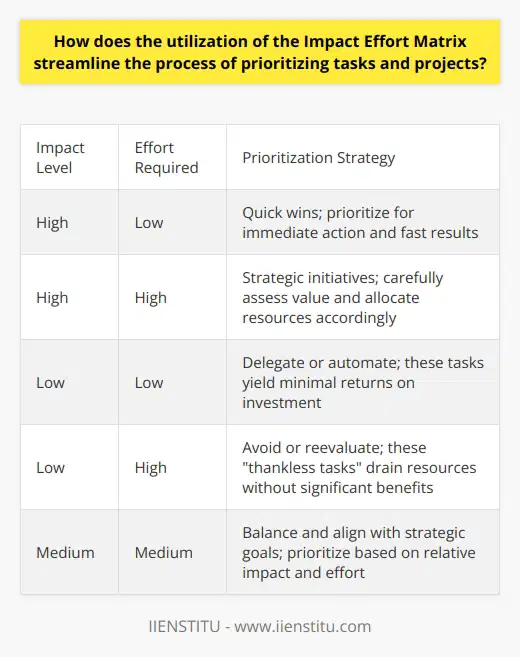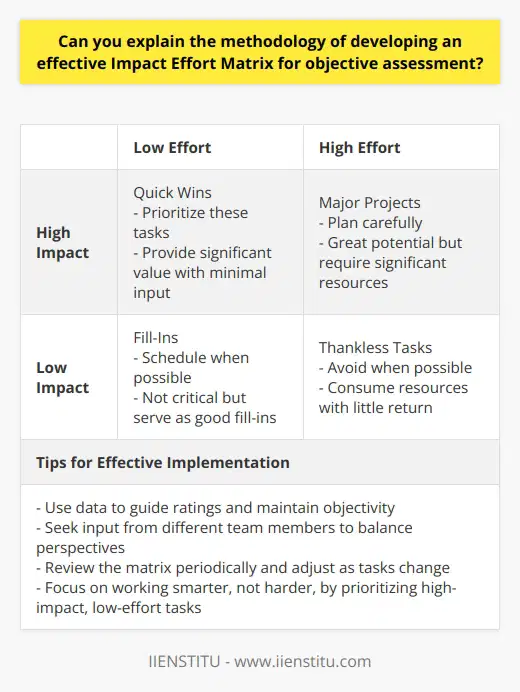
As I reflect on my journey through the maze of project management, I recall a time early in my career when our team was overwhelmed with a multitude of tasks. We were eager, enthusiastic, but utterly disorganized. It felt like we were spinning our wheels, exerting immense effort with little to show for it. That was until a seasoned mentor introduced us to the Impact Effort Matrix. This simple yet profound tool transformed the way we approached our projects, and I'd love to share how it can make a difference for you too.
Understanding the Impact Effort Matrix
At its core, the Impact Effort Matrix is a strategic decision-making tool designed to help teams prioritize tasks based on the potential impact and the effort required to complete them. Imagine a two-by-two grid where one axis represents the impact—the benefits or positive outcomes a task can deliver—and the other represents the effort—the resources, time, and energy needed to accomplish it.
Breaking Down the Quadrants
The matrix divides tasks into four distinct categories:
1- High Impact, Low Effort (Quick Wins): Tasks that can bring significant benefits with minimal effort. These are the low-hanging fruits that can boost morale and show immediate progress.
2- High Impact, High Effort (Major Projects): Initiatives that can greatly benefit the organization but require substantial resources. These are crucial but need careful planning.
High Impact, Low Effort: Quick Wins
High Impact, High Effort: Major Projects
Low Impact, Low Effort: Fill-Ins
Low Impact, High Effort: Thankless Tasks
3- Low Impact, Low Effort (Fill-Ins): Minor tasks that don't take much effort but also don't contribute significantly to goals. They can be slotted in when there's spare time.
Visual Management: A Comprehensive Approach to Effective Communication
5S Methodology: A Comprehensive Guide for Process Optimization in Businesses
4- Low Impact, High Effort (Thankless Tasks): Activities that consume resources without delivering meaningful results. These are best minimized or eliminated.
The Beauty of Visualization
By plotting tasks on this matrix, teams gain a visual representation of where to focus their efforts. It moves beyond gut feelings or subjective preferences, grounding decisions in a clear framework.
The Rationale Behind the Matrix
Why does the Impact Effort Matrix resonate so deeply with teams? It's because it aligns resources with strategic objectives, ensuring that what gets done drives the organization forward. In an era where resource allocation strategies in business operations are critical, the matrix offers a pragmatic approach.
Making Decisions Tangible
Often, teams struggle because priorities aren't clear. The matrix makes decisions tangible:
Quantifies Impact and Effort: Assigning values or ratings forces teams to objectively assess tasks.
Facilitates Discussion: It becomes a focal point for conversations about what's truly important.
Enhances Alignment: Ensures everyone's efforts are directed toward common goals.
How to Create an Impact Effort Matrix
Creating this matrix is both an art and a science. Here's how you can build one with your team:
1- List All Potential Tasks or Projects: Gather all ideas without filtering.
2- Assess the Impact of Each Task:
Will it increase revenue?
Does it improve customer satisfaction?
Will it enhance operational efficiency?
3. Evaluate the Effort Required:
How much time will it take?
What resources are needed?
Are there significant risks or challenges?
4. Plot Them on the Grid: Place each task in the appropriate quadrant.
5. Prioritize Accordingly:
Quick Wins: Tackle these first for immediate results.
Major Projects: Plan these carefully, allocating necessary resources.
Fill-Ins: Schedule these when time permits.
Thankless Tasks: Re-evaluate or discard.
Tips for Effective Implementation
Be Honest and Objective: Avoid overestimating impact or underestimating effort.
Involve the Team: Collaborative assessment ensures diverse perspectives.
Regularly Revisit the Matrix: As projects progress, re-assessing can provide fresh insights.
Avoiding Common Pitfalls
While the Impact Effort Matrix is straightforward, there are traps to watch out for:
Subjectivity in Scoring: Personal biases can skew the assessment. Establish clear criteria.
Neglecting External Factors: Consider market trends, customer needs, and competitive dynamics.
Overlooking Interdependencies: Some tasks may be prerequisites for others.
Practical Applications Across Industries
The versatility of the Impact Effort Matrix means it can be applied in various contexts. Let me share a few examples:
In Supply Chain Management
A colleague once faced challenges optimizing their company's supply chain. By using the matrix, they identified quick wins like renegotiating with local suppliers (high impact, low effort) and planned major projects such as integrating advanced logistics software (high impact, high effort). This approach provided optimize supply chain management process tips that streamlined operations and reduced costs.
In Technology Development
In tech startups, where resources are tight, prioritizing features is crucial. The matrix helps product teams decide which functionalities to develop first, ensuring they deliver maximum value to users without overextending themselves.
In Marketing Campaigns
Marketing teams often juggle multiple campaigns. By assessing the potential reach and required investment, they can focus on initiatives that promise the best return on investment.
Personal Experiences with the Matrix
I recall a project where our team was tasked with improving customer satisfaction. We brainstormed numerous initiatives, from revamping the website to enhancing customer service training. Using the Impact Effort Matrix:
We identified that updating the FAQ section (high impact, low effort) could quickly address common customer queries.
Developing a mobile app (high impact, high effort) was deemed a major project, slated for the next quarter.
Creating a monthly newsletter (low impact, low effort) was added as a fill-in task.
Upgrading our entire CRM system (low impact, high effort) was postponed, as it didn't align with immediate goals.
This structured approach not only clarified our path forward but also improved team cohesion and focus.
Enhancing Team Productivity
Implementing the Impact Effort Matrix can significantly improve team productivity with impact effort matrix strategies:
Clarifies Priorities: Everyone knows what's important.
Allocates Resources Wisely: Ensures effort isn't wasted on low-impact tasks.
Boosts Morale: Quick wins provide a sense of accomplishment.
Facilitates Better Communication: Regular discussions around the matrix keep everyone aligned.
Leveraging the Matrix for Better Prioritization
The matrix isn't just a tool—it's a mindset. By consistently applying it, teams develop a habit of strategic thinking and informed decision-making.
Case Studies on Impact Effort Matrix Usage
In a study featured in "Strategic Project Management" by Dr. Eleanor Thompson, organizations that adopted the Impact Effort Matrix saw a 25% increase in project success rates. Similarly, "Effective Resource Allocation" by Professor Luis Martinez highlights how businesses reduced unnecessary expenditures by 15% using the matrix to guide decisions.
Conclusion
Embracing the Impact Effort Matrix was a game-changer for me and countless others in the field of project management. It's more than a grid—it's a compass that guides teams through the complexities of strategic planning and execution.
By understanding and applying this tool:
You prioritize tasks that align with your organization's goals.
Resources are utilized efficiently, avoiding burnout and wastage.
Teams become agile, focusing on what truly matters.
Whether you're a seasoned professional or just starting out, I encourage you to explore the Impact Effort Matrix. It might just be the key to unlocking greater efficiency and success in your projects.
References
Thompson, E. (2018). Strategic Project Management. New York: HarperCollins Publishers.
Martinez, L. (2020). Effective Resource Allocation. London: Oxford University Press.
Johnson, M. (2017). The Art of Prioritization: Tools and Techniques. Boston: McGraw-Hill Education.
Smith, A. & Lee, K. (2019). Innovative Decision-Making Strategies. Chicago: University of Chicago Press.
Davis, R. (2021). Optimizing Supply Chain Management. San Francisco: Jossey-Bass.
In the ever-evolving landscape of business management, tools like the Impact Effort Matrix stand out for their simplicity and effectiveness. By incorporating them into your workflow, you're not just managing projects—you're steering your organization towards sustained success.
Frequently Asked Questions
What is the relationship between the Impact Effort Matrix and strategic decision making?
Understanding the Impact Effort Matrix
The Impact Effort Matrix stands as a vital tool. It categorizes tasks based on two factors: impact and effort. This matrix aids managers in making strategic decisions. It aligns their choices with broader organizational goals.
Intersection of Impact and Effort
Impact refers to the potential benefits of an action. Effort denotes the resources required for implementation. The matrix draws four quadrants from these axes:
- High Impact, Low Effort (Quick Wins)
- High Impact, High Effort (Major Projects)
- Low Impact, Low Effort (Fill-Ins)
- Low Impact, High Effort (Thankless Tasks)
Each quadrant informs strategy.
Strategic Decision Making
Strategic decision making steers an organization's direction. Leaders focus on decisions that yield the greatest benefits. They must allocate resources efficiently. Time is a scarce commodity. Thus, high impact, low effort tasks often take precedence.
Quick Wins in Strategy
Quick Wins are compelling in strategic planning. They offer immediate value. Work begins here often. This boosts morale, displaying visible progress.
Major Projects' Role
Major Projects require careful consideration. They are resource-intensive. Yet, their long-term payoffs can be transformative.
Handling Fill-Ins and Thankless Tasks
Fill-Ins can enhance productivity during downtime. However, one should avoid Thankless Tasks. They drain resources.
Integrating the Matrix with Strategy
The matrix serves as a strategic filter. Decision-makers evaluate initiatives against it. They seek alignment with key strategic pillars. The framework simplifies complex decisions. It clarifies choices. Leaders can then drive strategic agendas forward. They achieve this by focusing on pivotal initiatives.
Each quadrant impacts strategy differently. Efforts align with organizational vision. Resources direct towards high-yield projects. This ensures a strategic advantage. Firms benefit from optimized resource allocation. They can also avoid pitfalls of misaligned efforts. In essence, the matrix guides strategic road-mapping. It offers a pragmatic approach to decision-making. This ensures efforts translate into strategic success.

How does the utilization of the Impact Effort Matrix streamline the process of prioritizing tasks and projects?
Introduction to the Impact Effort Matrix
The Impact Effort Matrix simplifies task prioritization. It plots tasks on a grid. Impact and effort measure these tasks. High-impact, low-effort tasks become obvious through this view.
Assessing Impact
Tasks differ in their potential impact. The matrix requires impact assessment. Project impacts matter for goal advancement. Impact varies: significant, moderate, or minimal.
Evaluating Effort
Effort relates to resource consumption. It includes time, money, and labor. Projects demand varying efforts levels. The matrix helps compare these.
How the Matrix Streamlines Prioritization
The matrix creates a visual guide. It allows for quick comparisons. Priorities emerge from this ordering. The tool eases decision fatigue. Teams grasp where to focus fast.
Quick Identification of Quick Wins
Quick wins stand out on the matrix. They show high impact, low effort. These tasks promise big returns. Prioritizing them speeds progress. Low-hanging fruits become actionable items.
Avoiding Low Value Tasks
Low-impact, high-effort tasks appear too. They rank low on the priority list. The matrix labels them as "thankless tasks." Teams avoid these resource drains.
Balancing Resource Distribution
Some projects lie in between. They require more thought. The matrix suggests a balanced approach. It poses: "Are these worth the effort?"
Encouraging Delegation
Not all tasks need leadership's attention. The matrix identifies delegation candidates. Simple yet low-impact tasks suit delegation. This frees up leadership time. Higher-impact tasks earn that attention.
The Impact Effort Matrix streamlines workload management. It aids in quick, effective decision-making. Priorities align with strategic goals. This tool maximizes efficiency and productivity. Teams see where to direct energies. Results follow from focused efforts. The matrix serves as a roadmap for success.

Can you explain the methodology of developing an effective Impact Effort Matrix for objective assessment?
Understanding the Impact Effort Matrix
An Impact Effort Matrix aids decision-making. It classifies ideas or tasks by the effort they require and the impact they will have. This allows teams to prioritize what they should work on first. The matrix has two axes: impact and effort.
Steps for Developing an Effective Impact Effort Matrix
Gather Your List of Tasks or Projects
Start by listing the tasks. Include everything that requires evaluation. Do not judge these tasks yet. Focus on compiling an exhaustive list.
Define "Impact" for Your Context
Impact means the positive change from an action. Set criteria for what 'high impact' and 'low impact' look like for your organization. These criteria should be objective and relevant. They may include profit increase, customer satisfaction, market share growth, or others.
Define "Effort"
Effort refers to the resources and time needed. Similar to impact, define what constitutes high and low effort. Think about hours, cost, and manpower.
Rate Each Task
Assess every task on your list. Assign a score for its impact and its effort. Use a numerical scale, like 1-10, for both axes. Keep ratings consistent. Avoid overestimating impact or underestimating effort.
Draw the Matrix
Create a two-dimensional chart. Label one axis "Impact" and the other "Effort." Divide each axis into high and low sections. This will create four quadrants.
Plot the Tasks on the Matrix
Place each task in the relevant quadrant. Low effort, high impact tasks go top left. High effort, high impact tasks go top right. Low effort, low impact tasks go bottom left. High effort, low impact tasks go bottom right.
Analyzing the Results
Quick Wins
These are in the low effort, high impact quadrant. Prioritize these. They provide significant value with minimal input.
Major Projects
These fall into the high effort, high impact section. Plan for these carefully. They have great potential but require significant resources.
Fill-Ins
Low effort and low impact tasks are in this quadrant. Schedule these when possible. They are not critical but serve as good fill-ins.
Thankless Tasks
These are high effort but low impact. Avoid these when possible. They tend to consume resources with little return.
Refine and Implement
Discuss findings with your team. Use the matrix to make informed decisions. Adjust as you learn more about each task's real-world impact and effort.
Maintain Objectivity
Use data to guide your ratings. Do not let personal biases influence the assessment. Seek input from different team members to balance perspectives.
Review Regularly
Revisit your matrix periodically. Tasks can change in their impact and effort requirements. Keep your matrix updated to reflect these changes.
Implementing an Impact Effort Matrix effectively hinges on objective assessment. Use clear definitions, consistent ratings, and regular reviews. This tool can markedly improve productivity and strategic focus. Remember, the goal is to work smarter, not harder, by prioritizing tasks that yield the most benefit for the least effort.



